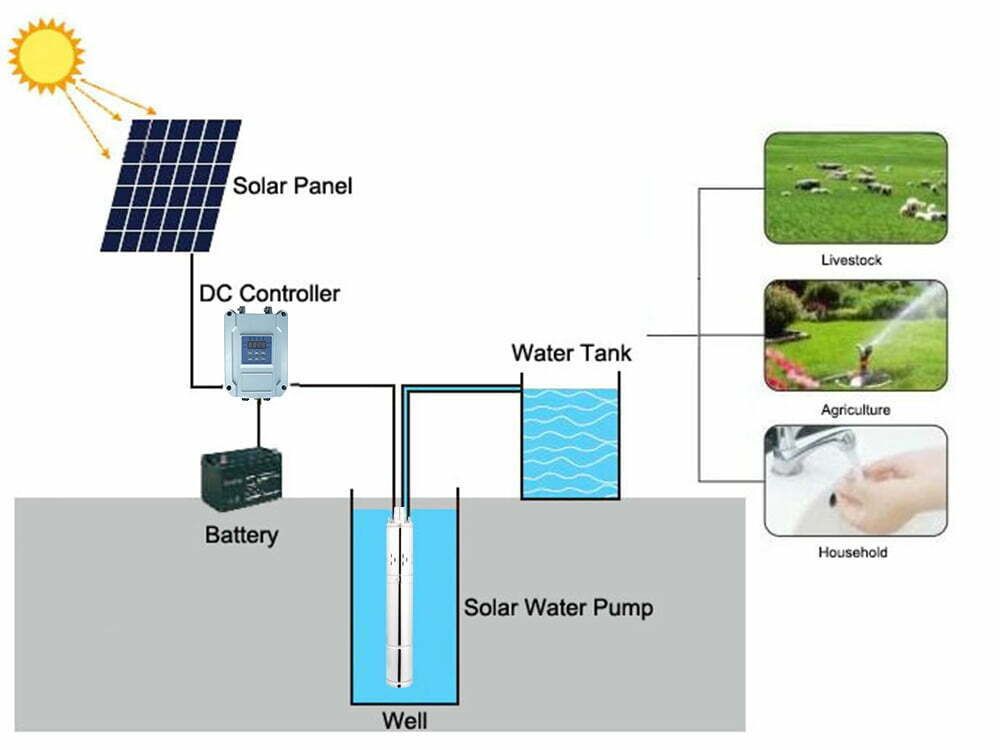“Photovoltaic water pump system” is also known as “solar photovoltaic water pump system”. Its basic principle is to use solar cells to directly convert solar energy into electrical energy, and then drive various motors to drive water pumps to lift water from deep wells, rivers, rivers, lakes, ponds and other water sources. It has many advantages, such as noiseless, fully automatic (work at sunrise and stop at sunset), high reliability, good adaptability between water supply and evaporation (“the sky is dry, it is dry”).
The United Nations International Development Program (UNDP), World Bank (WB), ESCAP and other international organizations have fully affirmed its advanced nature and rationality. Thousands of photovoltaic water pumps of different specifications operate in different regions and countries, especially in developing countries such as Asia, Africa, Latin America and the Middle East, which have brought considerable economic benefits to the people in many impoverished areas and accelerated poverty alleviation in these areas.
Since the photovoltaic water pump system is technically a typical “optical, mechanical and electrical integration” system, it involves the collection and transformation of solar energy and the latest technologies in many disciplines such as power electronics, motors, water machines, and computer control. Therefore, it has been listed as a high-tech and further development direction by many countries.
Many countries in the Middle East and Africa are looking forward to relying on solar water pumps, water-saving micro-irrigation, modern agriculture and other new technologies in droughts with abundant groundwater resources. Districts transform homes into oasis. Compared with diesel water pumps, photovoltaic water pumps have quite good economics.
The World Bank has made economic comparisons with clear conclusions in the oil-rich Middle East (such as the United Arab Emirates, Jordan and other countries), in terms of its water price per cubic meter, the system power of the photovoltaic water pump is equal to the water price of the diesel water pump 40kW, due to the price reduction of solar cells and other electronic control devices in recent years, the power of the two with the same water price is about 75kw.
If the price of solar cells drops to $3/wp, the power between the two will be around 150kW-200kW. Based on the experience of installing, testing and selling various specifications of photovoltaic water pumps around the world in recent years, Siemens of Germany has come to the conclusion that the initial investment of diesel engine water pumps is “low investment is its advantage, but with the increase of operating years, its operation Maintenance costs will continue to increase, and the cost per cubic meter of water will therefore increase year by year.
The large initial investment of photovoltaic water pumps is its disadvantage. However, due to its low operating costs and low maintenance or maintenance-free characteristics, the cost of its water rises very slowly. Ten years later, the water cost of diesel pumps will be the same as photovoltaic water pumps. That’s more than double the cost, and the break-even point for both is around three years. On the basis of the existing 4,000 photovoltaic water pumps in India, the government gives a certain subsidy plan to promote the installation of 50,000 sets of photovoltaic water pump systems, each with a capacity of 1-5kW.
The photovoltaic water pump system is roughly composed of four parts: photovoltaic array, controller, motor and water pump.
1) Photovoltaic Array
The photovoltaic array is composed of many solar cells in series and parallel, and its function is to directly convert the solar energy into electric energy in the form of direct current. At present, the solar cells used in photovoltaic water pump systems are mostly silicon solar cells, including monocrystalline silicon, polycrystalline silicon and amorphous silicon solar cells. The volt-ampere characteristic curve of the solar cell is shown in Fig. It has strong nonlinearity. The voltage characteristic curve of the photovoltaic array has the same shape as that of the single solar cell.
If the differences in the production process of the single solar cell and the connection resistance between the components are ignored, it will have an ideal consistency of the photovoltaic array. The volt-ampere characteristic curve can be regarded as only the scale of the volt-ampere characteristic curve of a single solar cell to enlarge its coordinates in series and parallel mode.
2) Controller
As a photovoltaic water pump loaded by a photovoltaic array, its drive motor is sometimes a DC motor, sometimes an AC motor or even other new types of motors, which also have nonlinear properties. In this case, in order to make the photovoltaic pump system work in an ideal working condition, and in any sunshine, the maximum potential of the output power of the photovoltaic array must be exerted.
This requires an adapter to make the load between the electric ribs reach the maximum potential. “And, all, efficient and stable working state. The content of the adapter is mainly the maximum power” point tracker, inverter and some protection facilities.
3) Water Pump
The series of water pumps are introduced in the article, please refer to: What is the Classification of Solar Pumps?
In next article, the details of controller will be introduced: MPPT controller & inverter.



